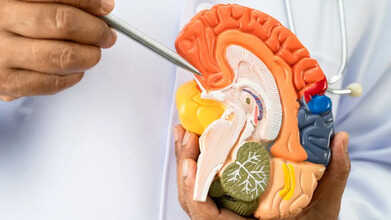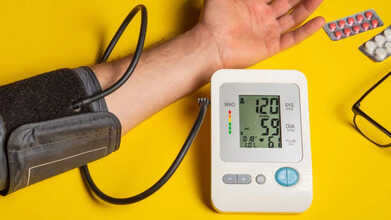- Health Conditions A-Z
- Health & Wellness
- Nutrition
- Fitness
- Health News
- Ayurveda
- Videos
- Medicine A-Z
- Parenting
- Web Stories
Uncontrolled Laughing Or Crying Is Linked To 5 Dangerous Conditions

Image Credit: Canva
Emotions are an organic and essential component of human life. They help individuals convey messages to others, reduce stress, and connect to the surroundings. However, in the case of some people, emotional responses are no longer in their control. Sometimes, the reactions can be excessive, inappropriate, or entirely out of place. This is known as pseudobulbar affect, which refers to an uncontrolled and sometimes exaggerated laughing or crying condition.
Although PBA itself is not a disease, it is closely related to neurological disorders and brain injuries. The effects of PBA can be distressing, but understanding its causes and treatment options can help manage its impact on daily life.
What Is Pseudobulbar Affect (PBA)?
PBA is a neurological condition that causes sudden, involuntary emotional outbursts. These episodes can manifest themselves through excessive laughing or crying that is inappropriate considering the context of the situation. These individuals experience extreme reactions with PBA, such as laughter during serious moments or tears in the absence of sadness, apparently without any emotional precipitate. These outbursts also occur for longer periods than may be expected in normal circumstances and are not easily controlled to see when or how long they occur.
Although PBA is not life-threatening, it can significantly affect a person's social and emotional well-being. People who experience PBA may find themselves embarrassed, frustrated, or isolated, as their emotional responses seem out of sync with their true feelings.
Studies estimate that up to 7 million Americans exhibit symptoms of PBA, and approximately 2 million individuals are diagnosed with the condition. PBA is most often seen in patients who have experienced a brain injury or suffer from neurological diseases. In some cases, PBA symptoms may be mistaken for mood disorders such as depression or anxiety, but the underlying causes are related to brain dysfunction rather than emotional instability.
What Causes PBA?
The root cause of pseudobulbar affect lies in the dysfunction of the central nervous system (CNS). More specifically, PBA results from damage to the brain's emotional regulation pathways, particularly the areas that control laughter and crying. Damage to these areas leads to involuntary emotional outbursts that are disconnected from the person’s actual feelings. Several neurological conditions can disrupt these pathways and increase the likelihood of developing PBA.
Here are five major conditions associated with PBA:
1. Stroke
A stroke occurs when blood flow to the brain is interrupted, depriving brain cells of oxygen and leading to their damage or death. This can result in physical disabilities, cognitive impairments, and emotional disturbances. Between 28% and 52% of stroke survivors experience PBA, with those assigned female at birth being at a higher risk. The symptoms of PBA are sometimes hard to differentiate from other effects that a stroke can bring.
Accurate diagnosis is very important. If you or someone you care about has had a stroke and cannot stop laughing or crying, you need to talk to a doctor, because these symptoms could mean PBA rather than a mood disorder.
2. Traumatic Brain Injury (TBI)
Traumatic brain injury often occurs due to external forces such as falls, car accidents, or sports injuries. TBIs can be a concussion or severe damage to the brain, and PBA is a common result of major head trauma. Studies have found that 5-48% of people with TBI develop symptoms of PBA, though this range varies due to underreporting and misdiagnosis.
Symptoms may be confused with another condition like depression or post-traumatic stress disorder, which can make them discuss emotional changes with a doctor who may have the patient referred for further neurology evaluation.
3. Multiple Sclerosis (MS)
Multiple sclerosis is an autoimmune disease in which the body's immune system fights against the protective covering of nerve fibers in the CNS, bringing about the disintegration of the communication process between the brain and the body. People with MS are more susceptible to developing PBA and have shown a prevalence rate of 10% from studies among patients with symptoms of involuntary laughter or crying.
MS-related brain lesions and the utilization of certain drugs can contribute to developing PBA. The lack of predictability of PBA can be especially problematic for an MS patient because it can create problems with social interactions as well as quality of life.
4. Amyotrophic Lateral Sclerosis (ALS)
Amyotrophic lateral sclerosis (ALS) is a progressive, neurodegenerative disease that affects cells in the nerve responsible for controlling voluntary movements of the muscles. As the motor neurons degenerate, patients begin experiencing muscle weakness, loss of mobility, and eventually, a failure to breathe. About 10% of patients with ALS develop PBA, in which crying is more common than laughing.
While ALS itself inflicts much physical and emotional stress, PBA can make an already difficult emotional experience even worse for patients and their families to bear.
5. Parkinson's Disease and Dementia
Parkinson's disease is a progressive neurological disorder affecting movement. PBA often occurs in advanced Parkinson's disease. The prevalence of PBA symptoms among Parkinson's patients has been reported to be 3.6% to 42.5%. In addition, the cognitive decline in Alzheimer's disease can also lead to PBA, and the prevalence among these patients has been estimated to be as high as 40%.
These conditions often have fluctuations in mood, which could be mistaken for mood disorders, complicating the diagnosis. Therefore, identification of symptoms of PBA in patients with Parkinson's and dementia is essential to ensure that these patients get proper care and support.
Symptoms of PBA
The symptoms of PBA are varied but usually involve:
- Increased emotional reactions: Laughter or crying for longer durations or of more intensity than the situation requires.
- Inappropriate crying and laughing: Laughing without a reason, e.g., at a solemn ceremony, or crying without having the feeling of sadness.
- Abrupt start: Episodes of crying and laughing can start without an identifiable emotional trigger.
- Inability to stop the episode: Unlike typical emotional outbursts, individuals with PBA are not able to control or end the episode once started.
- Emotional changes: Crying can change quickly into laughing, or vice versa, without any recognizable trigger.
Treatment for PBA
Although PBA is not a life-threatening condition, it can be very disruptive. There are treatments available to help manage the symptoms. Dextromethorphan/quinidine (Nuedexta) is the only FDA-approved medication specifically for PBA. This drug works by changing the way certain neurotransmitters function in the brain, helping to control emotional outbursts. In addition, antidepressants may be prescribed off-label to help alleviate symptoms in some cases.
Beyond medication, therapy and support groups can be very helpful in managing the social and emotional challenges of living with PBA. Cognitive-behavioral therapy (CBT) may help individuals understand their emotional responses and develop coping strategies to reduce the impact of PBA on their lives.
Pseudobulbar affect is a condition that can result from several serious neurological disorders. While the involuntary laughing and crying symptoms themselves are disturbing, it's the connection of PBA to brain dysfunction that will eventually lead to proper treatment and support for the patient.
If your loved one or you have sudden uncontrollable outbursts emotionally, it's essential to seek a comprehensive evaluation from the healthcare professional. With the right diagnosis and management plan, individuals with PBA can improve their emotional regulation and continue to live fulfilling lives despite the challenges of their condition.
Pseudobulbar affect (PBA).Multiple Sclerosis Association of America. 2010.
Pseudobulbar aPseudobulbar affect (PBA)ffect (PBA). American Stroke Association.
Alzheimer’s In Women: Why Women Are At Higher Risk And How To Detect It Early

Image credits: Canva
Did you know that among the 6.2 million Americans aged 65 and older living with Alzheimer’s disease, nearly two-thirds are women? This means women are almost twice as likely as men to develop the condition. While longer life expectancy partly explains the difference, research shows that hormonal changes after menopause, genetic factors, and certain lifestyle patterns also increase risk.
As a result, understanding the early warning signs and taking preventive steps is especially important for women, who face a higher likelihood of developing Alzheimer’s as they age.
Women and Alzheimer’s: Why The Risk Is Higher
Dr. Brij Lal Choudhary, Consultant Neurologist at Manipal Hospital, Jaipur, points out that Alzheimer’s is often seen as a condition of old age, but women are disproportionately affected. Nearly two-thirds of Alzheimer’s patients are women, making it almost twice as common in women compared to men. While longer life expectancy plays a role, other factors, such as hormonal changes after menopause, genetic predisposition, and lifestyle patterns also increase risk.
Early Signs of Alzheimer’s Women Should Watch
Recognising early symptoms is key, as catching them in time can make a significant difference. Common signs include:Memory loss: Forgetting recent events, appointments, or familiar names, with lapses gradually worsening.
ALSO READ: Chronic Insomnia Could Increase The Risk Of Dementia By 40%: Study
- Difficulty managing tasks or problem-solving: Struggling with daily responsibilities, finances, or planning may indicate cognitive changes.
- Confusion: Feeling disoriented over simple or familiar activities.
- Mood or personality changes: Sudden anxiety, frequent irritability, or withdrawing from social life.
- Language difficulties: Trouble finding the right words or expressing thoughts clearly.
Increased Risk of Alzheimer's in WomenStudies consistently show that women are at a higher risk of developing Alzheimer's disease compared to men. For instance, a Swedish study involving 16,926 participants found that, starting around age 80, women were more likely to be diagnosed with Alzheimer's than men of the same age. Similarly, research in Taiwan indicated that over a seven-year period, women had a higher likelihood of developing Alzheimer's compared to men. A European meta-analysis revealed that approximately 13 women out of 1,000 developed Alzheimer's each year, compared to only seven men, as per Harvard Health Publishing.
ALSO READ: CDC Vaccine Panel Updates COVID-19 Guidelines: What You Need To Know
While the longer life expectancy of women contributes to this disparity, it doesn't fully explain the difference. Even among individuals of the same age, women are more likely to be diagnosed with Alzheimer's than men. This suggests that factors beyond longevity, such as hormonal changes, genetic predispositions, and immune system differences, may play significant roles in the increased risk for women.
How to Reduce Risk and Protect Cognitive HealthAlthough Alzheimer’s cannot be reversed, several steps can help lower risk and support brain health:
- Regular cognitive screenings to monitor changes over time.
- Mental stimulation through reading, puzzles, or learning new skills.
- Physical exercise to improve blood flow and overall health.
- Managing blood pressure and blood sugar to reduce vascular-related risks.
World Alzheimer’s Day 2025: 5 Early Warning Signs of Alzheimer’s Experts Say You Must Know

Credits: Canva
We all experience occasional forgetfulness or feel a bit scatterbrained from time to time, often attributing it to stress, a busy lifestyle, or simply getting older. However, repeated lapses in memory, confusion, or difficulty performing everyday tasks can sometimes signal the early stages of Alzheimer’s or other forms of dementia. Recognising these warning signs early is crucial, as timely awareness and intervention can help manage the condition more effectively and improve quality of life.
As we observe World Alzheimer’s Day 2025, it’s the perfect moment to learn about Alzheimer’s, understand its early indicators, and know what experts recommend paying attention to.
What Is Alzheimer’s?
Alzheimer’s disease is the most common form of dementia, a progressive brain disorder that gradually declines memory, thinking, and reasoning skills. It affects cognitive functioning and daily behaviours to such an extent that simple tasks, like eating, dressing, or walking can become challenging over time.ALSO READ: Chronic Insomnia Could Increase The Risk Of Dementia By 40%: Study
For most people, symptoms first appear in their mid-60s, according to the National Institute on Aging. Current estimates indicate that over 6 million Americans aged 65 and older may be living with Alzheimer’s. Age remains the greatest known risk factor, and with the population aging, the number of cases is expected to rise.
Stages of Alzheimer’sAlzheimer’s disease progresses gradually, with symptoms worsening over time. It is generally divided into three stages: early (mild), middle (moderate), and late (severe). In the early stage, memory lapses and confusion begin to interfere with daily life. During the middle stage, challenges with language, reasoning, and daily activities become more pronounced. In the late stage, individuals may lose the ability to communicate, require full-time care, and become highly dependent on others. Understanding the stages helps families and caregivers plan support and interventions more effectively.
Alzheimer’s vs Dementia
While Alzheimer’s is the most common cause of dementia, the two terms are not interchangeable. Dementia is a broad term describing a decline in cognitive function severe enough to interfere with daily life. Alzheimer’s specifically refers to a progressive brain disease marked by amyloid plaques and tau tangles, leading to memory loss and impaired thinking. Other types of dementia include vascular dementia, Lewy body dementia, and frontotemporal dementia, each with distinct causes and symptoms. Knowing the difference is essential for accurate diagnosis and treatment planning.Early Warning Signs of Alzheimer’s
Recognising the early warning signs of Alzheimer’s can help with timely diagnosis and care. Dr. Prajwal Rao, DM Neurology, Professor and Head of the Department of Neurology at Dr. D. Y Patil Medical College, Hospital and Research Center, Pimpri, Pune, explains:- Persistent Memory Loss: Forgetting recent conversations, events, or important dates more often than usual, affecting daily life.
- Difficulty in Planning or Problem-Solving: Challenges with tasks like handling finances, following recipes, or keeping track of everyday responsibilities.
- Impairment of Spatial Memory: Forgetting familiar routes or even one’s way back home.
- Changes in Mood or Personality: Increased irritability, withdrawal from social activities, or unexpected anxiety and depression.
Blood Pressure Monitoring: How Often Should Patients With Controlled Hypertension Check Their Readings

Credits: Canva
Blood pressure monitoring plays a key role in managing hypertension. For patients whose numbers are well controlled through lifestyle changes or medication, the question often arises: how often should they be checking at home? While regular monitoring helps track progress and detect changes early, checking too frequently can increase stress or lead to unnecessary worry. On the other hand, checking too infrequently may delay important adjustments in treatment. Below, we take a look at how much frequency is important to check your blood pressure.
Home Blood Pressure Monitoring: How Often To Track Your Readings
When you have controlled hypertension, checking your readings at home with a validated monitor is important but doing it properly matters just as much. The CDC and American Heart Association recommend measuring at the same times each day, usually once in the morning and once in the evening. Take at least two readings, spaced 1-2 minutes apart, then average them.
Avoid caffeine, smoking, or exercise in the 30 minutes before taking a reading. Sit quietly for five minutes beforehand, keep your back supported, feet flat on the floor, arm at heart level, cuff on bare skin, and don’t talk during the measurement.
ALSO READ: American Heart Association Updates Hypertension Guidelines: Here’s What To Know
How many times per week? For people with stable, well-controlled blood pressure, checking 3 to 4 times per week may be sufficient. If just starting home monitoring or adjusting treatment, doctors may ask for readings over a week (3-7 days) to get a clear picture.
What is Ambulatory Blood Pressure Monitoring?
Ambulatory blood pressure monitoring (ABPM) is a method doctors use to track and understand high blood pressure over an entire day. Hypertension is diagnosed when the upper reading (systolic) is 130 mmHg or higher, or the lower reading (diastolic) is 80 mmHg or higher.
Unlike the usual check-up at a clinic, where a doctor measures your blood pressure once or twice with a cuff, ABPM gives a more complete picture. For this test, you wear a cuff on your arm that’s connected to a small device strapped to your waist or shoulder. The device automatically takes your blood pressure at regular intervals, every 15 to 30 minutes during the day and about once an hour at night, while you carry on with your normal activities, including sleep.
By the end of 24 hours, your doctor has dozens of readings instead of just one or two. This allows them to see your average blood pressure, how it changes throughout the day and night, and whether there are any unusual patterns. The device also records your heart rate, which adds more detail to the overall assessment.
Why Monitoring Matters Even When Blood Pressure Is Controlled?
Even if your blood pressure is well-controlled with medication or lifestyle changes, regular monitoring remains essential. Blood pressure can fluctuate due to stress, illness, sleep patterns, diet, or physical activity. Some patients may experience ‘masked hypertension,’ where readings appear normal in a clinic but are elevated at home, or ‘white coat hypertension,’ where anxiety in a medical setting temporarily raises readings.ALSO READ: H3N2 Flu Wave Hits Delhi: Paracetamol and Dolo Failing, Expert Reveals What to Take Instead
Tracking your blood pressure helps detect these patterns early, allowing timely adjustments in treatment and preventing long-term complications such as heart attack, stroke, or kidney damage. According to the American Heart Association, even small, consistent changes in readings over time can provide critical insights for maintaining cardiovascular health.
© 2024 Bennett, Coleman & Company Limited

